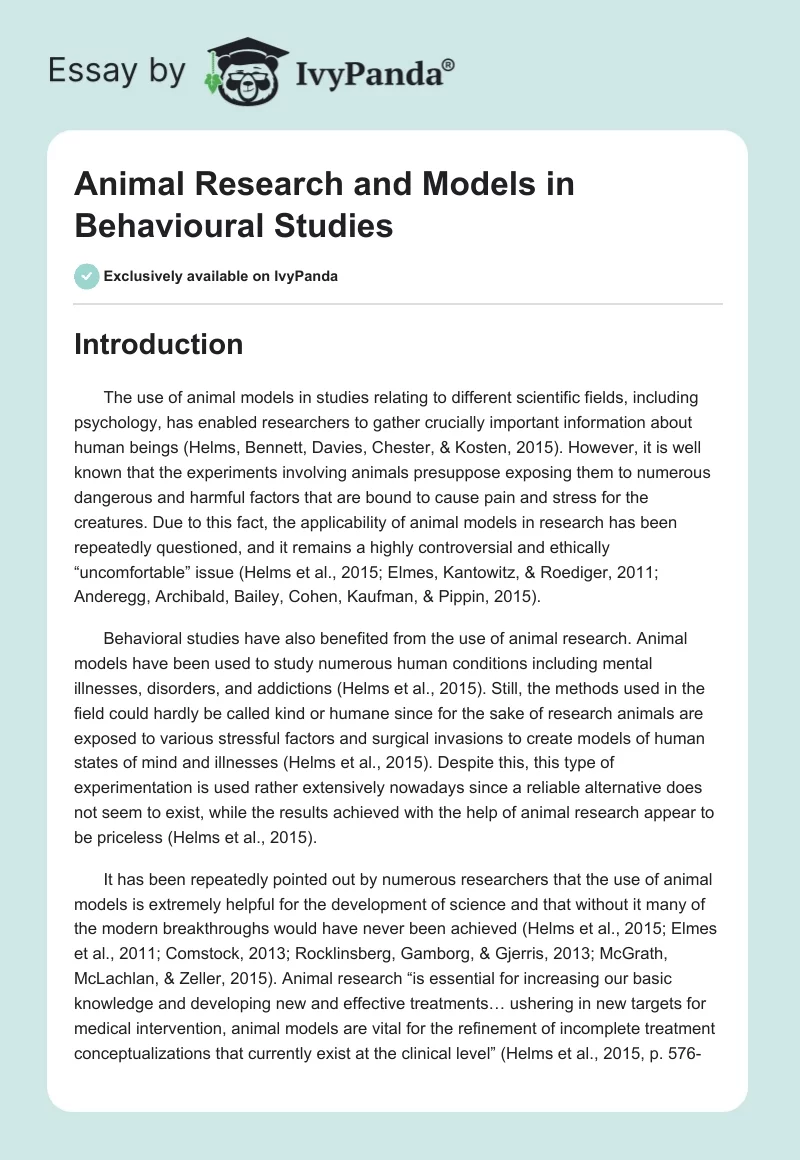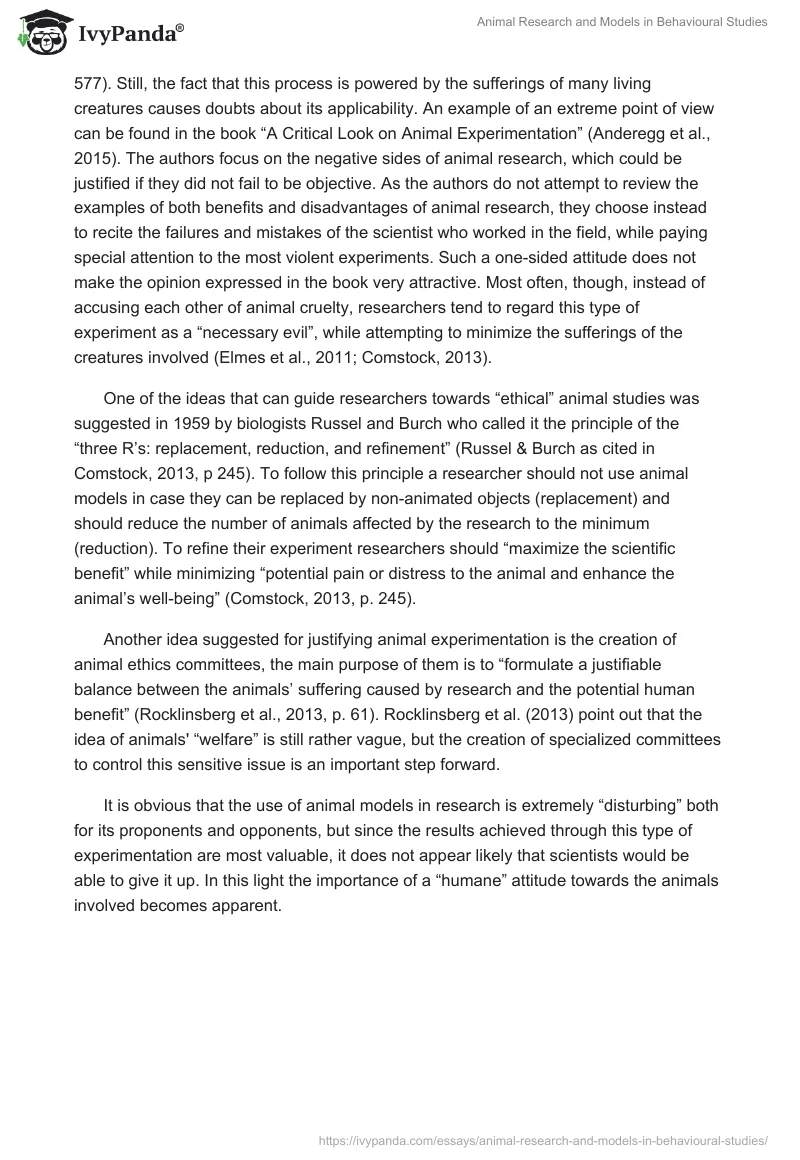Introduction
The use of animal models in studies relating to different scientific fields, including psychology, has enabled researchers to gather crucially important information about human beings (Helms, Bennett, Davies, Chester, & Kosten, 2015). However, it is well known that the experiments involving animals presuppose exposing them to numerous dangerous and harmful factors that are bound to cause pain and stress for the creatures. Due to this fact, the applicability of animal models in research has been repeatedly questioned, and it remains a highly controversial and ethically “uncomfortable” issue (Helms et al., 2015; Elmes, Kantowitz, & Roediger, 2011; Anderegg, Archibald, Bailey, Cohen, Kaufman, & Pippin, 2015).
Behavioral studies have also benefited from the use of animal research. Animal models have been used to study numerous human conditions including mental illnesses, disorders, and addictions (Helms et al., 2015). Still, the methods used in the field could hardly be called kind or humane since for the sake of research animals are exposed to various stressful factors and surgical invasions to create models of human states of mind and illnesses (Helms et al., 2015). Despite this, this type of experimentation is used rather extensively nowadays since a reliable alternative does not seem to exist, while the results achieved with the help of animal research appear to be priceless (Helms et al., 2015).
It has been repeatedly pointed out by numerous researchers that the use of animal models is extremely helpful for the development of science and that without it many of the modern breakthroughs would have never been achieved (Helms et al., 2015; Elmes et al., 2011; Comstock, 2013; Rocklinsberg, Gamborg, & Gjerris, 2013; McGrath, McLachlan, & Zeller, 2015). Animal research “is essential for increasing our basic knowledge and developing new and effective treatments… ushering in new targets for medical intervention, animal models are vital for the refinement of incomplete treatment conceptualizations that currently exist at the clinical level” (Helms et al., 2015, p. 576-577). Still, the fact that this process is powered by the sufferings of many living creatures causes doubts about its applicability. An example of an extreme point of view can be found in the book “A Critical Look on Animal Experimentation” (Anderegg et al., 2015). The authors focus on the negative sides of animal research, which could be justified if they did not fail to be objective. As the authors do not attempt to review the examples of both benefits and disadvantages of animal research, they choose instead to recite the failures and mistakes of the scientist who worked in the field, while paying special attention to the most violent experiments. Such a one-sided attitude does not make the opinion expressed in the book very attractive. Most often, though, instead of accusing each other of animal cruelty, researchers tend to regard this type of experiment as a “necessary evil”, while attempting to minimize the sufferings of the creatures involved (Elmes et al., 2011; Comstock, 2013).
One of the ideas that can guide researchers towards “ethical” animal studies was suggested in 1959 by biologists Russel and Burch who called it the principle of the “three R’s: replacement, reduction, and refinement” (Russel & Burch as cited in Comstock, 2013, p 245). To follow this principle a researcher should not use animal models in case they can be replaced by non-animated objects (replacement) and should reduce the number of animals affected by the research to the minimum (reduction). To refine their experiment researchers should “maximize the scientific benefit” while minimizing “potential pain or distress to the animal and enhance the animal’s well-being” (Comstock, 2013, p. 245).
Another idea suggested for justifying animal experimentation is the creation of animal ethics committees, the main purpose of them is to “formulate a justifiable balance between the animals’ suffering caused by research and the potential human benefit” (Rocklinsberg et al., 2013, p. 61). Rocklinsberg et al. (2013) point out that the idea of animals’ “welfare” is still rather vague, but the creation of specialized committees to control this sensitive issue is an important step forward.
It is obvious that the use of animal models in research is extremely “disturbing” both for its proponents and opponents, but since the results achieved through this type of experimentation are most valuable, it does not appear likely that scientists would be able to give it up. In this light the importance of a “humane” attitude towards the animals involved becomes apparent.
Article Review: “Effects of Early Life Trauma are Dependent on Genetic Predisposition”
The article that was chosen to illustrate the justifiable use of animal models for behavioral research is the report by Sterley, Howells, and Russell (2011) entitled “Effects of Early Life Trauma is Dependent on Genetic Predisposition: a Rat Study”.
Short Summary
To find out how genetic predisposition to attention-deficit/hyperactivity disorder (ADHD) modifies the consequences of early life trauma, the researchers have conducted an experiment that involved the maternal separation of rats of two strains: the spontaneously hypertensive rats and the Wistar-Kyoto rats. The former strain was regarded as an animal model of people predisposed to ADHD and the latter as the model of those non-predisposed to ADHD. The researchers assessed the changes in the behavior of the rats through a series of tests: those “on anxiety-like behavior (elevated-plus maze) and depressive-like behavior (forced swim test)” (Sterley et al., 2011). The level of corticosterone (a rodent hormone the prolonged secretion of which indicates stress) was also measured.
Results of the Research
The rats from different strains exhibited completely different behavior. This allowed the researchers to suggest that genetic predisposition to disorders like ADHD indeed affects the consequences of early life trauma and may lead to the development “of hyperactivity rather than anxiety and depression” (Sterley et al., 2011, p. 11). The level of corticosterone has proven to be useful as a “marker for susceptibility to a certain behavioral temperament” (Sterley et al., 2011, p. 11). Finally, the results of the research have allowed scientists to propose that sex also affects the response of an individual to an early life trauma with female rats responding “in a more active way to an acute, inescapable stress” (Sterley et al., 2011, p. 11).
Animal Models in the Research
As has been mentioned, the experiment involved exposing rats to traumatic events including maternal separation. The principle of replacement could not be applied here, while the principle of refinement could. As it is pointed out in the report, the living conditions of the rats were perfectly adequate. They were kept in clean cages, the temperature of the air being optimal; they were never left in isolation, instead of being kept in small groups even when the pups were taken away from their dams. The rodents were also swiftly and painlessly decapitated to collect their plasma and determine their corticosterone level. The researchers have taken all the necessary steps to keep the animals healthy and to avoid causing more suffering than was necessary owing to the nature of the experiment.
Successful and Less Successful Features of the Research
The researchers stated a specific problem, rationalized its importance, and were consistent in undertaking the steps to solve it. They chose an appropriate animal model for their experiment along with a control strain and performed several tests to provide proper ground for their conclusions. They prepared a detailed report of their experiment and pointed out the topics for further research on the matter. Unfortunately, the research involved forcing rats through traumatic experiences and eventually decapitating them. Still, the animals used as models for the study were treated appropriately and the sufferings they were forced through were a necessity justified by the achieved results.
Conclusions
All things considered, we may conclude that the use of animal models in the research under consideration is perfectly justified since the information gathered does contribute to our understanding of human behavior, while the attitude towards the animals that were experimented upon had been humane and their sufferings had been minimized. The research appears to be a valid example of the justifiable use of animal research in behavioral studies.
It is known that violations of the common principles of animal experimentation ethics do take place, but it can hardly be regarded as a reason to give up this most effective type of research (Elmes et al., 2011). It would be reasonable to remember that, while presupposing kindness in general, the word “humane” refers first and foremost to care about people and their wellbeing. Therefore, refusing the valuable instrument that animal research has become would truly be difficult to justify. As long as animal research in behavioral studies keeps providing humanity with vital information, it is reasonable, although it is obvious that through minimizing the sufferings of the living beings involved researchers preserve their dignity. The balance between the scientific benefit obtained through research and the sufferings of living creatures involved may be difficult to find, but from the point of view of modern science, the use of animal models is a necessary evil and can hardly be avoided.
References
Anderegg, C., Archibald, K., Bailey, J., Cohen, M., Kaufman, S., & Pippin, J. (2015). A Critical Look at Animal Experimentation. Cleveland, Ohio: Medical Research Modernization Committee.
Comstock, G. (2013). Research ethics. Cambridge: Cambridge University Press.
Elmes, D., Kantowitz, B., & Roediger, H. (2011). Research methods in psychology (9th ed.). Pacific Grove: Brooks/Cole Pub.
Helms, C., Bell, R., Bennett, A., Davies, D., Chester, J., & Kosten, T. et al. (2015). The Importance of Animals in Advancing Research on Alcohol Use Disorders. Alcoholism: Clinical And Experimental Research, 39(4), 575-578. doi:10.1111/acer.12668
McGrath, J., McLachlan, E., & Zeller, R. (2015). Transparency in Research involving Animals: The Basel Declaration and new principles for reporting research in BJP manuscripts. British Journal Of Pharmacology, 172(10), 2427-2432. doi:10.1111/bph.12956
Rocklinsberg, H., Gamborg, C., & Gjerris, M. (2013). A case for integrity: gains from including more than animal welfare in animal ethics committee deliberations. Laboratory Animals, 48(1), 61-71. doi:10.1177/0023677213514220
Sterley, T., Howells, F., & Russell, V. (2011). Effects of early life trauma are dependent on genetic predisposition: a rat study. Behavioral and Brain Functions, 7(1), 11. doi:10.1186/1744-9081-7-11


